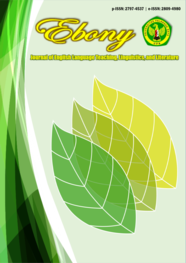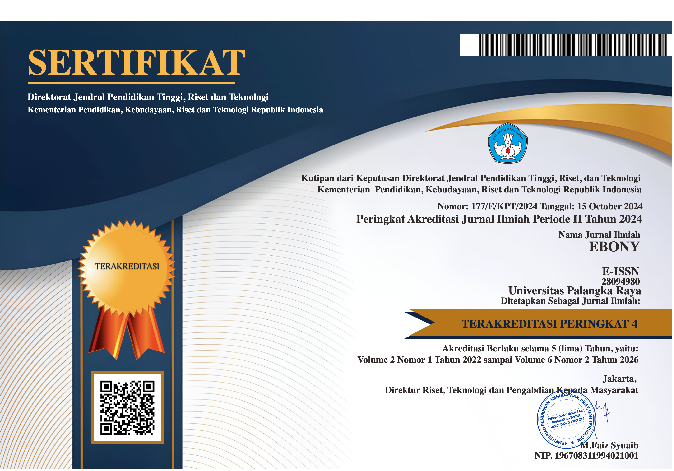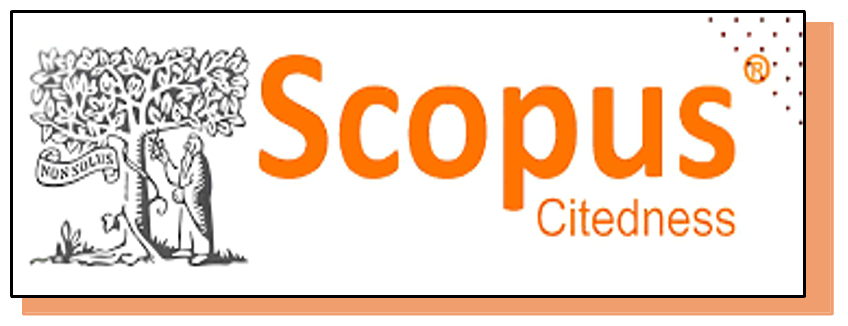Exploring the Representation of Gender in Foklores from Central Kalimantan
DOI:
https://doi.org/10.37304/ebony.v5i1.17820Keywords:
folklores, gender representation, gender stereotypeAbstract
Folklores are frequently used as teaching media at schools. However, they are suspected to contain gender stereotypes. This study aims to examine the gender representation and gender stereotypes in 28 folklores from Central Kalimantan published in two books by the Ministry of Education and Culture of the Republic of Indonesia in 1982 and 1995. Gender representation is explored through the roles and occurrence of the characters in the folklores, while four categories of gender stereotypes (personality traits, domestic behaviors, occupations, and physical appearances) are used to investigate the gender stereotypes attached to the male and female characters in the stories. The results show there is an imbalanced representation of male and female characters in Central Kalimantan folklores; from the total of 106 characters, male representation has almost twice in occurrence (60.4%) compared to the female one (39.6%). Mostly, males are the main characters in the stories having both positive or negative roles, and the females have only inferior roles. The gender stereotypes of patriarchy are found to be promoted through the characters’ description in the folklores. Therefore, to represent the proper concept of gender equality through stories, a critical view is needed in selecting folklores as teaching media at schools.Downloads
References
Amala, B. M., & Ekasiswanto, R. (2013). Objektivikasi Perempuan Dalam Lima Cerita Rakyat Indonesia: Analisis Kritik Sastra Feminis. Semiotika, 14(2), 139–154. https://repository.ugm.ac.id/128490/
Amri, S. H. (2021). Analisis Gender Dalam Cerita Rakyat (Kajian Semiotika Roland Barthes) (Gender Analysis in Folklore (the Semiotic Study of Roland Barthes)). Kibas Cenderawasih, 18(1), 100–113. https://doi.org/10.26499/kc.v18i1.296
Atqi, A. A. H. (2022). The Representation of Gender Bias in Children’s Literature Kingdom Tale Collections. Jurnal Basis, 9(2), 291–302. https://doi.org/10.33884/basisupb.v9i2.6367
Berlianti, A. D. (2021). The Stereotypical Representation of Women in the Classic Fairy Tales Snow White, Cinderella, and Sleeping Beauty. Indonesian Journal of Social Sciences, 13(1), 21. https://doi.org/10.20473/ijss.v13i1.26352
Casey, K., Novick, K., & Lourenco, S. F. (2021). Sixty Years of Gender Representation in Children’s Books: Conditions Associated with Overrepresentation of Male versus Female Protagonists. PLoS ONE, 16(12), 1–19. https://doi.org/10.1371/journal.pone.0260566
Team Penyusun. (1982). Cerita Rakyat Daerah Kalimantan Tengah. Departemen Pendidikan dan Kebudayaan. Proyek Inventarisasi dan Dokumentasi Kebudayaan Daerah. Jakarta.
Rampai, Kiwok D., Agus B. Amann., Angie Rohan BA. (1995) Cerita Rakyat Daerah Kalimantan Tengah. Proyek Pembinaan Perpustakaan Umum Dati II pada Dinas P dan K Propinsi Dati I. Kalimantan Tengah.
Danandjaja, James. (2007). Folklor Indonesia: IlmuGosip, Dongeng, dan Lain-lain. Jakarta: Pustaka Utama Grafiti.
Harris, J. K., Croston, M. A., Hutti, E. T., & Eyler, A. A. (2020). Diversify the Syllabi: Underrepresentation of Female Authors in College Course Readings. PLoS ONE, 15(10 October), 1–14. https://doi.org/10.1371/journal.pone.0239012
Hidayati, N. N. (2019). Women Portrayal in Indonesian Folklores: A Semiotic Study. An-Nas, 3(1), 66–81. https://doi.org/10.36840/an-nas.v3i1.177
Ibrahim Al-Barazenji, L. (2015). Women’s Voice and Images in Folk Tales and Fairy Tales. IJASOS-International E-Journal of Advances in Social Sciences, I(1), 47–53.
Kittilä, S. (2020). Folklore as an Evidential Category. Folia Linguistica, 54(3), 697–721. https://doi.org/10.1515/folia-2020-2051
Lutters, E. (2006). Kunci Sukses Menulis Skenario. Jakarta. PT. Grasindo.
Moran, M. (2019). Gender Issues in Folklore: A Study with Special Reference to Some Assamese Proverbs. International Journal of Humanities and Social Science Invention, 8(03), 60–64. https://www.ijhssi.org/papers/vol8(3)/Series-2/J0803026064.pdf.
Rhubido, D., et.al. (2024). Gender in Indonesian Folklore: A Corpus Linguistic Study. PIJCU, Vol. 1, No. 2. Proceeding of International Joint Conference on UNESA.
Parenthood, P. (2018). What Are Gender Roles and Stereotypes?. Planned Parenthood Federation of America Inc.
Saddhono, K., & Erwinsyah, H. (2018). Folklore As Local Wisdom for Teaching Materialsin Bipa Program (Indonesian for Foreign Speakers). KnE Social Sciences, 3(10), 444. https://doi.org/10.18502/kss.v3i10.2926
Surya, D. W. (2022). Traditional Representation of Women in Indonesian and English Folktales. Jurnal Sipakalebbi, 6(2), 131–139. https://doi.org/10.24252/sipakallebbi.v6i2.34601
Wiyatmi, W. (2023). Queens in Folklores as Representation of Indonesian Feminism. Poetika, 11(1), 22. https://doi.org/10.22146/poetika.v11i1.81810
Zhao, W. (2022). The impact of gender stereotypes in education on female students’ psychological development. Proceedings of the 2022 3rd International Conference on Mental Health, Education and Human Development (MHEHD 2022), 670(Mhehd), 1012–1017. https://doi.org/10.2991/assehr.k.220704.184
Downloads
Published
How to Cite
Issue
Section
License
Copyright (c) 2025 Indah Wulandari, Erma Sujiyani, Olga Dona Retsi, Susanty

This work is licensed under a Creative Commons Attribution 4.0 International License.











